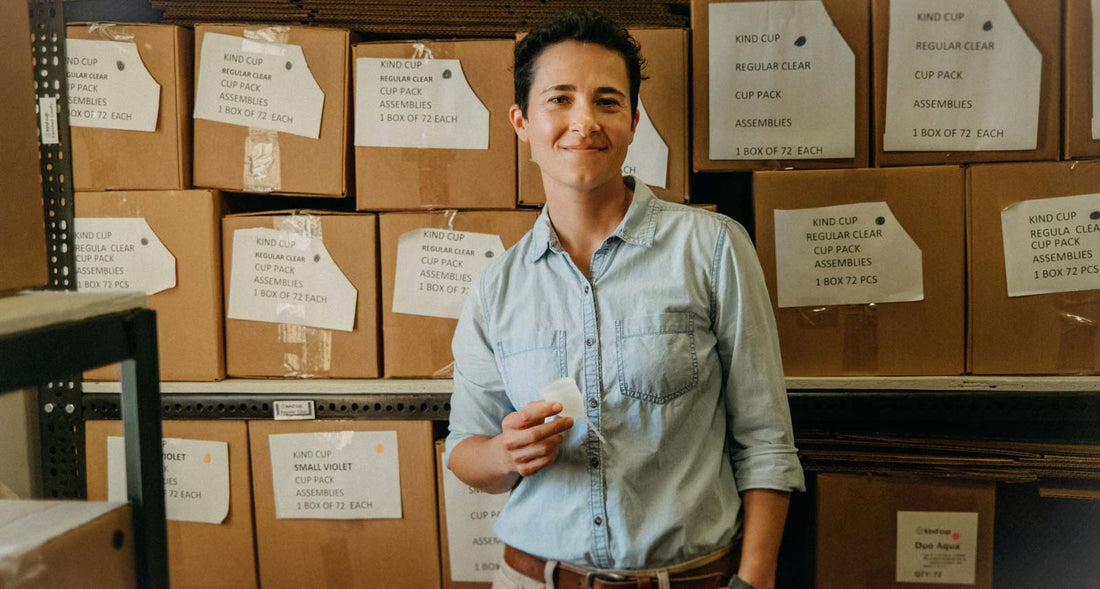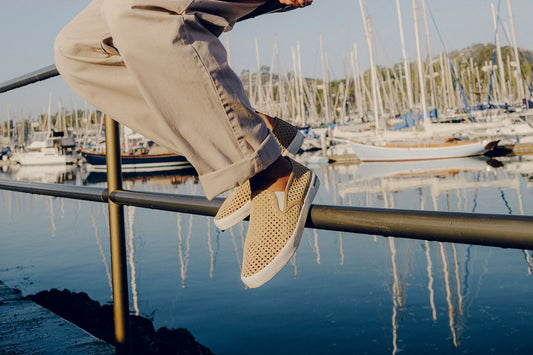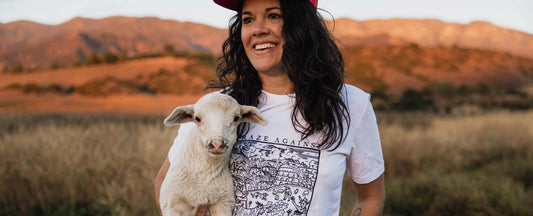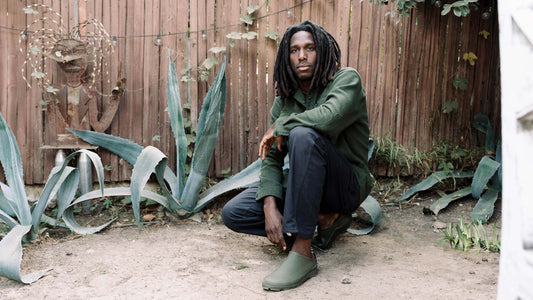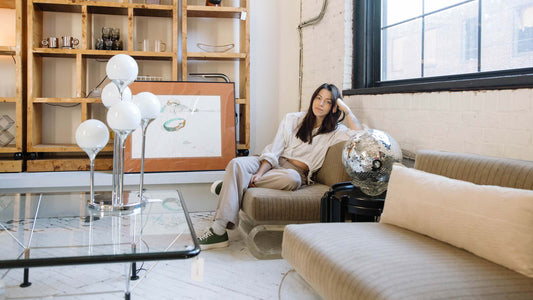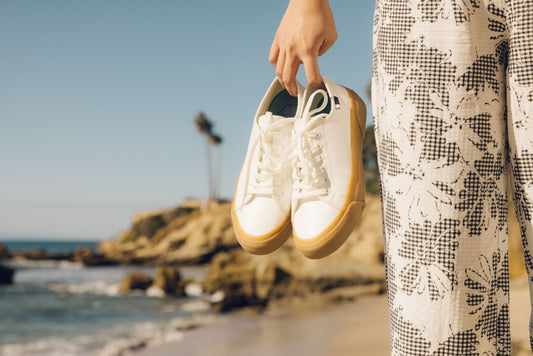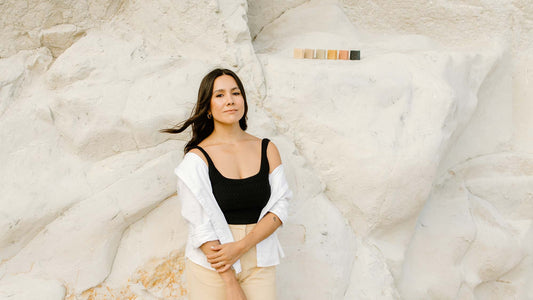If you spend any time with Christine Brown, expect to leave with an armful of fruit from her family’s sixth-generation coastal California farm. “I actually helped patent a new cherimoya variety,” Christine says, holding up the dimpled green fruit in her hand. Combined with the patents she acquired when designing Kind Cup, an ergonomic medical-grade menstrual cup, Christine actually holds patents in all three categories.
A former American Sign Language professor with a background in architecture and design, Christine’s long been passionate about using design to create a world that fits people instead of asking people to fit into the world. Now, she’s taking on period products in pursuit of a better menstrual experience, raising the standards for an entire industry in the process.
As told to SeaVees. Photography by Johnie Gall
“I went to an all women’s college but somehow I’d never heard of a menstrual cup. Years after graduating, a friend had her cup sitting out amongst all of her earrings on the counter, so I picked it up and asked, ‘Where’s the matching earring and why is this one so weird looking?’ She gave me a strange look and explained what it was [laughs]. This was way before menstrual cups were something you could just order online, so I biked all over the city until I found one. It’s not like I had had a negative experience with tampons or anything but, I mean, who has had a good experience with one? They’re dry, scratchy, the string gets wet. It’s one of those negative experiences you just get conditioned to having as someone with a period. When I tried that first cup back in 2011, it was a total game changer.


I was working in architecture and design at the time, so I was already in the mindset of how to create designs that support the human experience instead of ones that force humans to adapt. I couldn’t stop thinking about how a menstrual cup could be better. Menstrual cups have actually been around since the 1930s, but they only became more mainstream in the last two decades. I wanted a better-fitting shape and easier-to-reach removal stem, but I figured the existing companies were working on it. Then a few years went by and I realized no one was doing anything about it. I finally got curious and after an online search, came across hundreds of reviews from people who were giving the existing cups their best try, using this technique or that one, and eventually giving up and going, ‘Well, I guess there is something wrong with my body.’ I didn’t have the money. I didn’t have the resources. I had no idea where to start, but I realized no one else thought like me. If I wanted to fix this problem, I had to be the one to do it.
“I don’t know if it was me, my designs, or those avocados, but I made an impression.”
The day after my 30th birthday I formed an LLC and started getting the legal foundation, research and development in place, and securing the patents on my design. A friend of mine happened to be a doctor who’s worked in medical devices and she suggested I meet with a material supplier right in town who was known to have the highest quality. I was cold calling and emailing these multi-million dollar international companies and taking meetings with experts and pretty much anyone who would talk with me after NDAs were in place. Here I was, a 30-year-old female-presenting nonbinary person with no prior experience in medical devices, but I needed them to take me seriously — I’d show up with a bag of beautiful avocados from my family’s farm and present my design and ideas. I don’t know if it was me, my designs, or those avocados, but I made an impression.

I’d taught American Sign Language, worked summers in education administration in Italy, and taken on weekend jobs for several years to finally save up $5,000. I took all of it and paid a CAD and material specialist to take my drawings and mold them into an actual 3D prototype — the minute I had that cup in my hand, I just knew it was right and thought, ‘Yeah. I’m doing this.” Something I’m really proud of is that I resisted going out and raising a ton of money because I wanted to hold true to my values and why I was doing this in the first place. It was a lot slower and a lot harder to do it that way, but I didn’t have to answer to anyone about sales goals or cutting costs in my commitment to using the highest quality, most sustainable materials.
“I think it’s so common that people have an idea and go raise a million dollars, but I would caution against it.”
Listen, I don’t know if you’ve seen my car, but it has rusted screws holding up the bumper and I have $50,000 in loans against it [laughs]. I asked several times if the lenders wanted to see the car first, but they told me they are willing to bet on me. I think it’s so common that people have an idea and go raise a million dollars, but I would caution against it. I don’t buy into the idea of failing fast. These tech bros crash and burn multi-million dollar companies and just move on. Where is the integrity in that?


As far as I know, I might be the only one-person medical device company out there. I’ve got a great team of consultants and experts who support me here and there, but day to day I’m overseeing research, development, supply chain, manufacturing, materials, packaging, marketing and of course actually designing the cup itself — because it’s a medical device, that means I pay $6,000 a year to register with the FDA. And that’s just to register, it doesn’t actually get you anything! There are multiple four-inch thick binders in my office full of regulatory paperwork that take hours to fill out. Some companies will just pay that fee and never do the rest of the stuff required by the FDA and it’s not like the FDA has the bandwidth to regularly check up on it. We recently had our first three-day FDA audit and despite our small size, did exceptionally well because doing it right and not cutting corners matters to me.
“You’ll know you’re on the right path when the universe continues to show up with that next step forward.”
The more I learn about this industry, the more incredibly frustrating it can be. One period underwear company just settled a class-action lawsuit because they were allegedly making a product with harmful chemicals in it. You’d hope these massive brands would want to do things the right way, but a lot of them just want to increase profit margins — it’s capitalism. But I know it’s totally possible to do things the right way, and it fuels me to keep going because if I can do it with values and integrity, there’s no excuse for the big brands.


I’m stubborn as hell, and I have grit — I don’t think this company would exist if I didn’t. I knew I wanted a challenge, but I’ve had to dig deeper and reach depths I didn’t even know I had. There have been times when I’m literally just lying on the floor of my office, my body is numb with stress, and tears are streaming down my face. I put a sticky note on the underside of a shelf that is just above my head that says, ‘You got this! You are making a difference.’ It was a huge leap of faith to do something that hadn’t been done before, and there was no guarantee it would work. But when I started getting feedback from strangers for the first time, people who owed me nothing saying my product changed their lives [tears up] — sorry, I’m getting emotional just thinking about it.
<
The ethos of Kind Cup from day one has been ‘kind to your body, the earth and others,’ so immediately after I launched Kind Cup, I dropped off our first donation to our nonprofit partner Direct Relief and just said, ‘Thank you for getting these where they need to go.’ I’d only sold maybe a couple cups at that point, but I didn’t care because I wanted giving back to be foundational to my business. That said, something I’ve been working on is defining more measurable objectives for myself so I can make sure I’m working toward milestones and not just five-star reviews. I love those, but I can’t get paid in reviews. I have to scale up, but I’m so proud of the foundation we’ve built and am excited for this next chapter in the journey.


My biggest piece of advice for others chasing a dream is to surround yourself with others who are on parallel paths, because so many of the referrals and connections I’ve made have been through my network of entrepreneurs. My other advice is to make sure what you’re doing or creating is actually needed, and in your pursuit of that, make sure you’re raising the standards. We don’t need more stuff — we need the opposite of that. Make sure you’re creating something that not only brings value to the world, but does good for it, too. You have to be passionate about your dream because it might end up being harder than you expect. If you pursue something that is bigger than yourself, it will help keep you inspired to find a way to make it happen. You’ll know you’re on the right path when the universe continues to show up with that next step forward.”
Christine wears the Baja Slip On in Marine.

